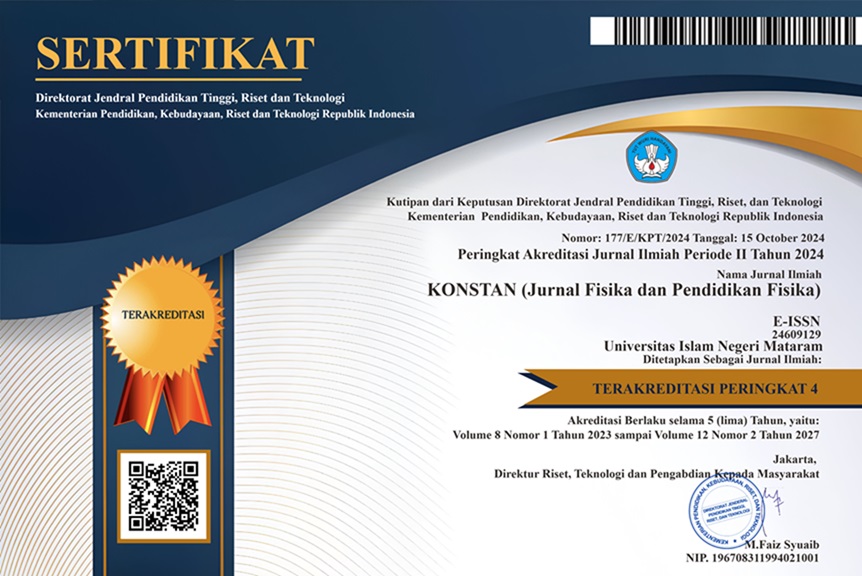Development of a STEAM-Based Module to Enhance HOTS (Analytical, Critical, and Creative Thinking) for Pre-service Science Teachers at UNISLA
Abstract
The demand for adaptive graduates in the Society 5.0 era necessitates the enhancement of Higher-Order Thinking Skills (HOTS). However, this is constrained by a lack of innovative teaching materials for pre-service science teachers at the Islamic University of Lamongan. This research aims to develop and assess the feasibility and effectiveness of a STEAM-based module designed to improve HOTS (analytical, critical, and creative thinking). Employing a 4D model of Research and Development (R&D), the product was validated by six experts and trialled with 25 students using a one-group pretest/posttest design. Data were analyzed using feasibility percentages and N-Gain scores. The results indicated that the module was declared "Very Feasible" by the experts, with scores of 88% for material content, 85.8% for language, and 90% for media. The module's implementation proved effective, achieving an average N-Gain score of 0.78 (categorized as "High"). This included improvements in creative thinking (N-Gain 0.85), critical thinking (N-Gain 0.78), and analytical thinking (N-Gain 0.69). Furthermore, the module received a highly positive response from students (89.2%). Therefore, this STEAM-based learning module is proven to be a valid and effective practical solution for enhancing the multiple dimensions of HOTS among pre-service teachers and can serve as a model for developing instructional materials in higher education.
Downloads
References
[2] F. Robi’ah and Prihantini, “Urgensi Kualitas Pendidik yang Sesuai dengan Kebijakan Pendidikan dalam Mencapai Standar Nasional Pendidikan,” Jurnal Review Pendidikan dan Pengajaran, vol. 7, no. 1, pp. 409–419, 2024.
[3] I. Arif, A. Lukman, and Z. Tuara I., “Penerapan Pendekatan Culturally Responsive Teaching Terintegrasi Etnokimia dalam Mengembangkan Keterampilan Siswa Abad 21 pada Materi Hidrolisis di MAN 1 TIKEP,” JIWP, vol. 7, no. 2, pp. 194–204, Apr. 2021, doi: 10.5281/zenodo.4661844.
[4] N. W. Ningsih, M. Polem, N. Azizah, Tarsono, and H. Hasbi, “Studi Komparatif Model Pembelajaran Contextual Teaching and Learning (CTL) Problem Based Learning (PBL) dan Konvensional dalam Meningkatkan Kemampuan Berpikir Kritis Siswa dalam Pembelajaran Abad 21,” JIIP - Jurnal Ilmiah Ilmu Pendidikan, vol. 6, no. 12, pp. 10001–10007, doi: 10.54371/jiip.v6i12.2468.
[5] K. Mahbubah, A. Santoso, S. R. Rosdiana, and R. Djatmiko, “Improving Junior High School Students’ Critical Thinking Through Scaffolding Methode on Heat Concept,” Konstan, vol. 9, no. 01, pp. 9–15, Jul. 2024, doi: 10.20414/konstan.v9i01.492.
[6] H. Rahmawati and R. K. Irawati, “Analisis Kebutuhan Bahan Ajar Kimia Organik yang Berorientasi Higher Order Thinking Skills,” J Educ, vol. 21, no. 1, pp. 68–82, Jun. 2023, doi: 10.31571/edukasi.v21i1.5323.
[7] Darmadi, Budiono, and M. Rifai, “Pembelajaran STEAM Sebagai Pembelajaran Inovatif,” MUDIMA, vol. 2, no. 8, pp. 3469–3474, Aug. 2022, doi: 10.55927/mudima.v2i8.924.
[8] S. D. Aini, C. F. Tafrilyanto, A. Subaidi, and L. Amalia, “Pengembangan Buku Ajar Digital Berbasis STEAM-PjBL pada Mata Kuliah Metode Numerik,” JMPM: Jurnal Matematika dan Pendidikan Matematika, vol. 8, no. 2, pp. 173–185, 2023, doi: 10.26594/jmpm.v8i2.4295.
[9] N. Najamuddin, R. Fitriani, and M. Puspandini, “Pengembangan Bahan Ajar Science, Technology, Engineering, Art and Mathematics (STEAM) Berbasis Loose Part untuk Meningkatkan Kemampuan Pemecahan Masalah Anak Usia Dini,” basicedu, vol. 6, no. 1, pp. 954–964, Jan. 2022, doi: 10.31004/basicedu.v6i1.2097.
[10] M. H. Rohman, P. Marwoto, S. E. Nugroho, and S. Supriyadi, “Persepsi Dan Pembiasaan Penggunaan Model Pembelajaran Berbasis Proyek Terintegrasi STEAM pada Mata Kuliah IPA: Studi Pendahuluan Tentang PjBL Terintegrasi Steam untuk Meningkatkan Keterampilan Abad 2,” in Prosiding Seminar Nasional Program Pascasarjana Universitas Negeri Semarang, 2021.
[11] A. Santoso, K. Mahbubah, and S. F. Alim, “Needs Analysis Teaching Materials of STEAM Approach in Innovative Learning Courses,” Didaktika: Jurnal Kependidikan, vol. 13, no. 4, 2024, doi: https://doi.org/10.58230/27454312.1223.
[12] Mellisa, I. Hajar, S. Herlina, Pebriani, and S. Anthonia, “Analysis Of Research-Based Hydroponic Module Development Needs,” Perspektif Pendidikan dan Keguruan, vol. 15, no. 1, pp. 1–7, 2024, doi: doi.org/10.25299/perspektif.2024.vol15(1).14974.
[13] D. Juniayanti and I. K. D. Susila, “Efektivitas Penggunaan Media PECS untuk Meningkatkan Kemampuan Berkomunikasi Anak Autis di SLB Negeri 1 Gianyar,” Jurnal Pendidikan Dan Konseling (Jpdk), vol. 4, no. 2, pp. 1–7, Mar. 2022, doi: https://doi.org/10.31004/jpdk.v4i2.3789.
[14] L. W. Anderson and D. R. Krathwohl, A taxonomy for learning, teaching, and assessing: A revision of Bloom’s taxonomy of educational objectives. New York: Longman, 2001.
[15] N. W. Ningsih, M. Polem, N. Azizah, T. Tarsono, and H. Hasbiyallah, “Studi Komparatif Model Pembelajaran Contextual Teaching and Learning (CTL) Problem Based Learning (PBL) dan Konvensional dalam Meningkatkan Kemampuan Berpikir Kritis Siswa dalam Pembelajaran Abad 21,” jiip, vol. 6, no. 12, pp. 10001–10007, Dec. 2023, doi: 10.54371/jiip.v6i12.2468.





